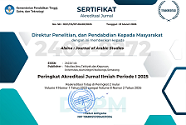Semantic Study of Halu' in The Qur'an
DOI:
https://doi.org/10.21580/alsina.1.2.2741Keywords:
Halu', Qur’anic method, Adversity QuotientAbstract
The study aimed to find out the meaning of halu' in the Qur'an, the relationship between halu and Adversity Quotient (AQ), and the Qur’anic management methods to address halu' as well as to enhance the Adversity Quotient (AQ). This study was a descriptive qualitative research with semantic approach. The data were collected through documentation method and analized by means of Syntagmatic Paradigmatic approach. The study found that halu' was a negative human potential to easily complain but hard to share with others because it was triggered by greed. It had potential to cause people to quickly give up, despair, and be selfish, thus causing self-difficulties to face challenges of life. It hampered an individual to be a strong personality and to achieve personal success. Therefore, human needed for specific methods to suppress and manage the negatif potential to avoid its negative effects. Halu' and AQ (Adversity Quotient) had a very close relationship. Halu' could be overcome by improving the level of Adversity Quotient (AQ). Thus, a high Adversity Quotient (AQ) was the solution for the problem of human’s halu'. The Qur’anic management methods in addressing halu' used to improve Adversity Quotient (AQ) were performing prayers, establishing prayers continuously, spending the property for infaq, believing in the day of judgment, feeling fear of the God’s punishment, having sexual intercourse only with a legitimate partner, fulfilling the mandate and promises, enforcing bear testimony, and keeping the prayers quality.Downloads
References
Abd al-Rahman bin Kamal Jalal al-Din al-Suyuthi, Tafsir al-Dur al-Mantsur fi Tafsir al-Ma’tsur Juz VIII (Beirut: Dar al-Fikr, Cet. I, 1983).
Abu Abdillah Muhammad bin Ahmad al-Anshari al-Qurthubi (next; al-Qurthubi), Tafsir al-Qurthubi: al-Jami’ li Ahkam al-Qur’an Juz 71 (Kairo: Dar al-Sya’bi, t.th.)
Abu al-Hasan Ali bin Muhammad bin Habib al-Mawardi al-Bashri, Al-Nukat wa al-‘Uyun Tafsir al-Mawardi Vol VI (Beirut: Dar al-Kutub al-‘Ilmiyyah, t.th.).
Abu Bakr Jabir al-Jaza'iri, Aisar at-Tafasir li al-Kalam al-'Aliy al-Kabir (Madinah al-Munawwarah: Maktabah al-'Ulum wa al Hikam, 1994)
Abu Zakaria Yahya bin Ziad al-Farra’, Ma’ani al-Qur’an Juz III (t. tp.: Turatsuna, t. th.)
Ahmad Musthafa al-Maraghi, Tafsir al-Maraghi terj. Bahrun Abu Bakar, LC., dkk Juz XXIX (Semarang: Toha Putra, Cet. II, 1993), p. 123.
Angela Wika Citra Kusuma, Sex Hundred and One (Benefit) (http://www.angelawika.seks101.com/, downloaded November 10, 2008).
Baum, J.R. and E.A. Locke. 2004. The relationship of entrepre-neurial traits, skill, and motivation tosubsequent ven-ture growth. J. Applied Psy., 89.
Dr. Ahmad Ibrahim Muhana, Al-Insan ( ).
Green, A. 2006. Effective personal communication skills for public relations. Creative print and design, USA. ISBN: 0-7494-4407-X
Hasbi al-Shiddieqy, Tafsir an-Nur Juz 29 (Jakarta: Crescent Star, Cet. I, 1973).
http://humanscience.wikia.com/wiki/Positive_and_Negative_Human_Traits
http://mohmansurfauzi.blogspot.com/2014/11/pendekatan-semantik-dalam-kajian-islam.html
Ibnu Mandzur, Lisan al-’Arab al-Mukhith Vol II (t. tp.: --, t. th.).
Imam Abu al-Fada’ al-Hafidh Ibnu Katsir al-Damsyqi, Tafsir al-Qur’an al-’Adhim Juz IV (Beirut: Maktabah al-Nur al-’Ilmiyyah, Cet. I, 1992)
Imam Abu Muhammad al-Husain bin Mas’ud al-Farra’ al-Baghawi al-Syafi’i, Tafsir al-Baghawi al-Musamma Ma’alim al-Tanzili Juz IV (Beirut: Dar al-Kitab al-‘Ilmiyyah, Cet. I, 1993)
Imam Musbikin, Rahasia Shalat bagi Penyembuhan Fisik dan Psikis: Terapi Religius (Secrets of Prayer for the Physi-cal and Psychic Healing: Religious Therapy) (Yogyakarta: Mitra Pustaka, cet. I, 2003)
Koonthaisong, M. 2003. Some mental features that correlated to the Adversity Quotient. M.Ed. Thesis. Mahasarakham: Mahasarakham University, Thailand, unpublished doc-ument.
M. Jawwad Maghniyyah, Al-Tafsir al-Kasyif Vol VII ( Beirut: Dar al-‘Ilm al-Malayin, Cet. I, 1970).
M. Quraish Shihab, Tafsir al-Mishbah: Pesan, Kesan, dan Kaserasian al-Qur’an Vol. 14 (Jakarta: Lentera Hati, 2002)
Muhammad Ali al-Shabuni, Shafwatu al-Tafasir Vol III (Bei-rut: Dar al-Qur’an al-Karim, Cet. II, 1981).
Reinhard Rapp, The Computation of Word Association: Com-paring Syntagmatig and Paradigmatic Aproaches (Uni-versity of Mainz, FASK. D-76711 Germersheim Ger-many, ucrel.lancs.ac.uk/acl/C/C02/C02-1007.pdf).
Richmond H. Thomason, What is semantics? (http://web.e-ecs.umich.edu/~rthomaso/documents/general/what-is-semantics.html).
Shaykh Hakim Abu Abdullah Ghulam Moinuddin ; The Book of Sufi Healing (Kitab al-Timm al-Rauhi al-Shufi).
Siti Chamamah Suratno, 2005, Ensiklopedi al-Qur’an Dunia Islam Modern Vol II (Yogyakarta: Dana Bhakti Prima Yasa).
Stoltz, P.G. 1997. Adversity Quotient: Turning Obstacles into Opportunities. John Wiley and Sons, USA., ISBN: 0-4711-7892-6.
Sulaiman bin ‘Amr al-‘Ajili al-Syafi’i, Al-Futuhat al-Ilahiyyah bi Taudlihi Tafsir al-Jalalain li al-Daqaiq al-Khafiyyah Juz IV (Mesir: Mathba’ah ’Isa al-Babi al-Khilbi, t.th.)
Syaikh Ahmad al-Shawi al-Maliki, Khasyiyah al-Shawi ‘ala Tafsir al-Jalalaini Juz VI (Beirut: Dar al-Fikr, Cet. I, 1988)
Syaikh Imam Abu Yahya Zakaria al-Anshari, Fatkhu al-Rahman bi Kasyfi ma Yaltabisu fi al-Qur’an (t. tp.: ’Alim al-Kutub, t. th.).
Theoretical Underpinnings of Vocabula;ry Learning and Teaching (http://cd1.edb.hkedcity.net/cd/eng/vocab09/ch1_3-2.htm
What is AQ? ( http://www.peaklearning.com/ , downloaded at 1 st December 2008).
Downloads
Published
How to Cite
Issue
Section
License
Copyright
The copyright of the received article shall be assigned to the publisher of the journal. The intended copyright includes the right to publish the article in various forms (including reprints). The journal maintains the publishing rights to published articles. Authors are allowed to use their articles for any legal purposes deemed necessary without written permission from the journal, but with an acknowledgment to this journal of initial publication.
Licensing
In order for Alsina: Journal of Arabic Studies to publish and distribute research articles, the editors need publishing rights (transferred from author to publisher). This agreement relates to the transfer/publishing copyright license to Alsina: Journal of Arabic Studies but the authors still have significant rights to use and share their published articles.
Alsina: Journal of Arabic Studies supports the need for writers to share, disseminate and maximize the impact of their research and their rights on any database. As a journal article writer, you have the right to various uses of your articles, including that by the institution or company where you work. Copyright can be used without the need for special permission. Authors who publish articles in the Alsina: Journal of Arabic Studies have broad rights to use their work for teaching and scientific purposes without requesting permission, including:
- Use by the author for lectures, presentations, or conferences, with distribution of copies to participants;
- Distribution to colleagues for research use;
- Use in compilations of the author's subsequent work;
- inclusion in a thesis or dissertation;
- Reuse of sections or excerpts from articles in other works (with full acknowledgment of the final article);
- Preparation of derivative works (other than commercial purposes) (with full acknowledgment of the final article);
- Voluntary posting on open websites operated by authors’ or writers' agencies for scientific purposes
When submitting a manuscript, authors do so on the understanding that if accepted for publication, the copyright for publishing (publishing right) of the article shall be assigned/transferred to Alsina: Journal of Arabic Studies.
Authors whose articles are accepted for publication will receive confirmation via email and sent a Copyright Transfer Agreement.


 Accreditation
Accreditation 
 In Collaboration with
In Collaboration with 

 Visitors
Visitors  Article Template
Article Template





